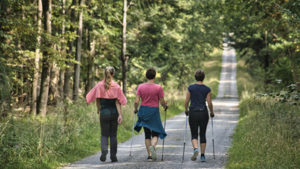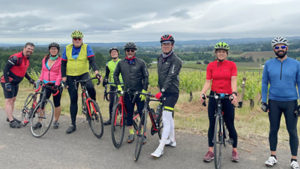Time to ride!

Photo by BikePortland
Now that we have warmer (and, hopefully soon, drier) weather and the snow is melting up high, it’s definitely time to ride outside! Cross-training will help with overall fitness, but now it’s time to get tuned in to the bike you’ll be using on the tour. If you have any fit issues, this is the time to find out and get it looked at and adjusted; you’ll still have time to get your body used to any changes.
May is about adding in harder efforts, maintaining your endurance base and RECOVERY. Now, don’t just jump into the harder efforts if you haven’t been doing the tempo intervals outlined last month. (Instead, go back and read my previous blogs from January through April, and follow the first few months of training guidelines, condensing them as needed.)
For those of you doing BRNW Montana in June, be sure to get in some good hill work; between Beartooth Pass on Day 2 and Chief Joseph Pass on Day 4, you’ll be glad you put in the climbing work now. If you can, ride somewhere where you can get in 35 to 60 miles with 2,000 to 5,000 feet of climbing, on several different days – it’s great for getting your body used to climbing, both for long endurance days and training intervals.
Recovery is crucial

Photo by Pixabay
Let’s talk about something really important that happens OFF the bike: recovery. What does recovery look like? Well, there are two types to consider.
Active recovery is when you do an easy activity such as walking, swimming or riding at a very easy pace and low heart rate for up to an hour. A cycling recovery workout usually means spinning a very easy gear with high RPMs and minimal pressure on the pedals; your HR should not be steeply elevated at any point, and you should barely break a sweat. These are best done on flat terrain. This allows blood to flow into your muscles and clear out any toxins left over from the training. Usually soreness will improve after a recovery spin if you go easy.
Inactive recovery is a natural process that happens when you let your body rest. I also include recovery nutrition in this category. Immediately after a ride or workout lasting more than 60 to 90 minutes, or anything of higher intensity, you need to take in some form of recovery nutrition. This needs to have both carbohydrates and some protein in there. It’s best to do this within 30 minutes of finishing your workout or ride. Drinking chocolate milk is a great form of recovery, and it’s offered at the finish line of BRNW events.
Recovery will be particularly important during your week-long BRNW tour, so you can continue to go long day after day. Your nutrition on the ride and immediately following each day’s ride is crucial to you feeling ready to go for the next day. Then get off your feet, do some foam rolling if you can, get a massage on some days, and always eat a good dinner and go to bed plenty early. Sleep is one of the most underrated performance enhancers – and it’s absolutely legal!
How intense is good?
What should your intensity be like this month? You can add in one day a week where you do some shorter hill repeats (3 to 6 min.) at a harder intensity, where you’re working hard and breathing hard. This is the zone where you can’t carry on a continuous conversation; it’s right at or just below when you get that burning feeling in your legs. Your heart rate is very close to your ventilatory threshold, which is the point where your breathing goes from steady to deep and hard.
The rest time after each interval should be the length of time of the interval – so one minute of rest for each minute of interval. Start with one of these the first week, then increase to three total intervals per workout by the end of the month. These types of workouts take more time to recover from, so you need to be aware of that. For this month, you can alternate these short hill intervals with the longer tempo intervals from last month on your interval days.
As with any interval workout, you want to be sure to include a good warmup and cool-down. Since these intervals are harder, you may need a little more warmup time. I recommend at least 30 to 45 minutes of easy riding, getting a sweat going, before you do the intervals.
Once you add in the harder intensity this month, I suggest decreasing your strength maintenance work to one day a week of full-body/light weight, at 10 to 15 reps, two sets; and another day doing a core routine. If you haven’t been doing a full-body strength routine, just continue with your core workout twice a week. This can also be replaced with yoga or Pilates.
Your plan for May

Photo by PortlandBikeClub
For most riders, in May try to get in 3 to 4 days a week of training, with one day of harder intervals, two days of endurance rides (building distance on one of them each week) and one day of strength and/or core work. You can alternate the threshold intervals and tempo intervals every other week.
Be sure you’re aware of how you’re feeling as you train. If you’re overly tired, take some extra recovery time. Overtraining syndrome can happen if you don’t take adequate recovery. Here is a great article about overtraining syndrome. Some people do better with a periodized training regimen where they take some solid recovery time (off or easy activity for a few days at the beginning of the week every 3 to 4 weeks).
I would also encourage you to find some longer club or organized rides to do; they’re a good way to get in some valuable endurance work, as well as meeting other riders. ORBike is a good resource for lists of organized rides.
Note: If you haven’t been cleared by your healthcare provider to do intense exercise like what’s mentioned here, don’t do it. Also, if at any time while riding hard you feel chest pain, lose sensation in any part of your body, or get blurred vision or dizziness, stop immediately and contact your healthcare provider.
This was adapted from a previous blog post by retired physician and professional performance trainer Anne Linton, who lives in Bend. If you’re interested in more in-depth coaching or training guidelines, feel free to email or go to her website at Linton Horner Coaching.